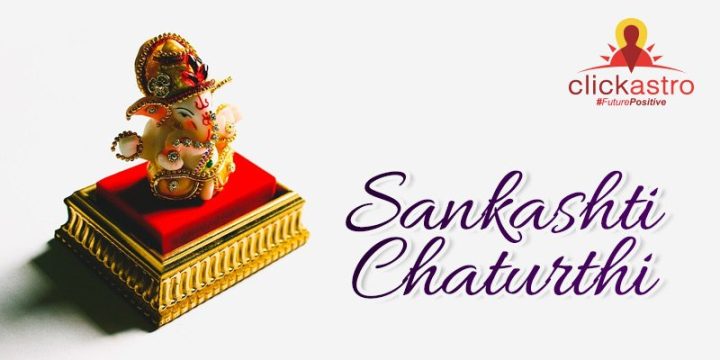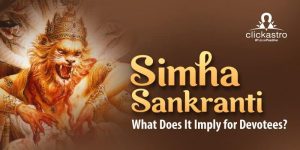Sankashti Chaturthi also known as Sankat Hara Chaturthi is observed every lunar month of the Hindu calendar on the fourth day of the dark lunar phase or the Krishna Paksha. This is an auspicious day devoted to Ganesha, the lord of knowledge, and good fortune. If Chaturthi falls on a Tuesday, it is called Angaraki Sankashti Chaturthi which is the most significant among all Sankashti Chaturthi days.
When is Sankashti Chaturthi 2020?
The upcoming Sankashti Chaturthi will be on Thursday, December 3, 2020. It is also known as Ganadhipa Sankashti Chaturthi.
Ganadhipa Sankashti Chathurthi 2020 Timings:
Ganadhipa Sankashti Chaturthi Date: Thursday, December 3, 2020
Chaturthi Tithi Begins: 07:26 PM, December 3, 2020
Chaturthi Tithi Ends: 08:03 PM, December 4, 2020
Moonrise timing on Sankashti Day – 08:36 PM, December 3, 2020
Get your 60-page FREE Kundli
Sankashti Chaturthi and Vinayaka Chaturthi
The Hindu Panchang indicates that the lunar month specifies two Chaturthi dates. Sankashti Chaturthi is celebrated on the full day during Krishna Paksha while Vinayaka Chaturthi is celebrated on the new moon day during Shukla Paksha. While we observe Sankashti Chaturthi for deliverance from difficult times, Vinayaka Chaturthi fasting is the acknowledgment of the power of the Lord Ganesha, who is the Supreme lord after Vishnu, Lakshmi, Shiva, and Parvathi. Sankashti Chaturthi is also popularly known as Sankata Hara Chaturthi, while Vinayaka Chaturthi is considered as Varada Vinayaka Chaturthi.
Pooja Vidhi for Ganadhipa Sankashti Chaturthi 2020
On the day of Sankashti Chaturthi, devotees wake up early and dedicate their entire day to worshipping Lord Ganesha. Ideally, a strict fast is observed in the honor of their deity; however, people can also keep a partial fast if they have any physical ailments. You can only consume fruits, vegetables, and roots of plants during the fast. The diet comprises peanuts, potatoes, and sabudana khichadi.
The Sankashti Puja is then performed in the evening after the moon has been sighted. The idol of Lord Ganesha is first cleaned with water and then the Panchamrit (5 liquids). Abhisheka (divine bath) is then performed on the idol of Lord Ganesha with milk, curd, ghee, honey and sugar, and banana while chanting “Om Gam Ganapathaye Namaha”. The idol is then again cleaned and turmeric and kumkum are applied. It is then decorated with Durva grass and fresh flowers. A lamp is also lit during this time and other rituals such as lighting incense and camphor while chanting the Ganesha Stotra, Stuthi, or Sri Ganesha Bijakshara Mantra. After this, the devotee reads the ‘Vrata Katha’ specific to the month. The fast should only be broken after worshipping Lord Ganesha in the evening and sighting the moon.
Special ‘naivedya’ comprising of modaks and other favourite dishes of Lord Ganesha are prepared as an offering. An aarti is then performed and later the prasad is distributed among all the devotees.
Get 55% OFF on Yearly Horoscope
Special puja rituals dedicated to the moon are also performed on Sankashti Chaturthi, which consists of sprinkling holy water, sandalwood paste, consecrated rice, and flowers in the direction of the moon.
On this day it is auspicious to recite the ‘Ganesha Ashtothra’, ‘Sankashtnashanasthothra’, and ‘Vakrathunda Mahakaya’ to name a few. In fact, any other Vedic mantras dedicated to Lord Ganesha can be chanted.
Before moonlight, reciting the Ganapati Atharvasheersha invokes the blessings of Lord Ganesha.
During Sankashta Chaturdashi 2020, Lord Ganesha is worshiped with a different name and Peeta (seat) which is as given below
|
Hindu Lunar Month
|
Name of Lord Ganesha whose pooja is performed |
Peeta Name
|
| Chaitra |
VikataMaha Ganapati |
Vinayaka Peeta |
| Vaishakha |
Chanakra Raja EkadantaGanapathi |
SrichakraPeeta |
| Jeshtha |
Krishna PingalaMaha Ganapati |
Sri ShakthiGanapathiPeeta |
| Ashadha |
Gajaanana Ganapati |
Vishnu Peeta |
| Shravana |
HerambaMaha Ganapati |
GanapathiPeeta |
| Bhadrapada |
VignarajaMaha Ganapati |
VigneshwaraPeeta |
| Ashweeja |
VakrathundaMaha Ganapati |
BhuvaneshwariPeeta |
| Karthika |
GanadipaMaha Ganapati |
Shiva Peeta |
| Margashira |
AkurathaMaha Ganapati |
DurgaPeeta |
| Pushya |
LambodaraMaha Ganapati |
SouraPeeta |
| Magha |
DwijapriyaMaha Ganapati |
Samanya deva Peeta |
| Phalguna |
BalachandraMaha Ganapati |
Agama Peeta |
| Adhika |
VibhuvanaPalakaMaha Ganapati |
DoorvaBilva Patra Peeta |
There is a total of 13 vrats, with each vrat depicting a specific purpose and story known as the “Vrata Katha”. The last Katha is for ‘adika’ that is the one extra month that comes every four years in the Hindu calendar.
How will be your 2021? Get personalized predictions now!
It is believed that on Sankashta Chaturthi, Lord Ganesha blesses all his devotees with his presence on earth. Lord Ganesh is revered as the god of wisdom, prosperity, and good fortune and is therefore traditionally invoked during the beginning of all ventures and travel.
Sankashti Chaturthi 2020 fast was first observed around 700 BC as a ritual to remove obstacles with regard to conflicting views of confidence which is explained by Abhisheka Maharishi to his pupil Aishwarya. Sankashti Chaturthi is celebrated both in the Northern and Southern states of India. The word “Sankashti” is derived from the Sanskrit word which means “deliverance from difficult times”. In Maharashtra, the Sankashti Chaturthi is celebrated elaborately and in splendor. Devotees worship Lord Ganesha on Sankashti Chaturdashi to overcome all the obstacles and emerge victorious in difficult circumstances.
Legend of Sankashti Chaturthi
Hindu Mythology indicates that Lord Ganesha was created by Goddess Parvathi, the consort of Lord Shiva. Legend has it that Lord Shiva had gone out leaving Goddess Parvathi alone in Kailasa. As Goddess Parvathi prepared to take her bath, she realized that she was alone and therefore created a human form out of the turmeric past that she used for her bath and breathed life into the figure. The young boy was then instructed by Goddess Parvathi to stand guard at her door while she took her bath and not allow anyone inside without her permission. As Goddess Parvathi was having her bath, Lord Shiva returned and was promptly blocked by young Ganesha, who did not know Lord Shiva. Shiva was enraged and asked him who the young boy was to block him at his own home. Ganesha replied that he was the son of Goddess Parvathi. Lord Shiva was livid with anger as he felt the boy was lying and he instructed the gods who followed him to teach the boy a lesson. Ganesha proved to be very powerful to the gods as he was the born of Parvathi, the epitome of Shakti or power. He defeated Shiva’s followers (also called Gana’s) and obstructed everyone from entering the gates while his mother took her bath. Even Narada, the sage of heavens along with the Saptarishis (seven wise rishis) were unable to appease young Ganesha.
When Lord Indra attacked Ganesha with his entire army, they too were defeated at the hands of a young child. This became a matter of pride for Lord Shiva, who in anger severed the head of the child after the trinity and all deities were defeated. When Parvathi saw her child being killed, she was distraught and filled with rage. She revealed her true self as Adi Shakti and took a terrible form. She vowed to destroy the universe which killed her son and rebuild a better universe. The gods panicked and Lord Shiva tried to appease her anger by promising to bring her son’s life back. The Trinity (Brahma, Vishnu, and Maheshwara) searched the world for a head and came across a dead baby elephant. They consoled the mother elephant and fixed the head of the baby elephant in place of Ganesha’s head. Lord Shiva christened him as Ganesha meaning Isha (Lord) of the Ganas.
Get your personalized 60-page FREE Kundli
The legend of Lord Shani’s glance
Legend also states another story. The story depicts the meeting of Sage Durvasa and Lord Indra. Once as Sage Durvasa was traveling from Vaikuntha to Kailasa, he met Lord Indra, who was spending time with the celestial dancer Rambha. Lord Indra respectfully bowed before Sage Durvasa. Indra was presented with a Parijata flower by Durvasa with the instructions that the Parijata flower was given by the Lord who was the destroyer of all obstacles and the person who wears the Parijata flower will be victorious in all aspects and will be revered and adored by all and will be the Supreme Lord. The wearer will be equal to Lord Vishnu in terms of knowledge, wisdom and strength and Goddess Mahalakshmi will always be a part of him and follow him like a shadow. Saying this Sage Durvasa left and Lord Indra, who was intoxicated in the presence of Rambha, placed the divine Parijatha flower on the head of his elephant. The elephant acquired all the qualities that were ordained by the flower. It fought and defeated all other elephants and left Lord Indra.
But destiny had other plans and it waited for the birth of Lord Ganesha. The story depicts the conversation between Goddess Parvathi and Lord Shani. The story goes that when Lord Ganesha was born all gods visited Kailasa to have a glimpse of the divine child of Goddess Parvathi and Lord Shiva. Lord Shani too came to Kailasa to see Lord Ganesha and requested Goddess Parvathi’s permission to see the young baby. Goddess Parvathi granted Lord Shani permission to see her baby; however, Lord Shani stood gazing downwards. He did not look at the child and was just satisfied standing near the baby. When Goddess Parvathi enquired the reason, Lord Shani replied that everyone faces the result of their deeds. The effects of both the good and bad deeds are not washed away even after completing crores of Kalpas (each Kalpa equates to 4.32 billion years). He further stated that one achieves hell and heaven as a result of their deeds. Lord Shani then confided to Goddess Parvathi that he was a staunch devotee of Lord Krishna and was devoted to him and would always recite his name. Lord Shani was married to the daughter of Chitraratha; however, he was only devoted to Lord Krishna and his meditation. Once while he was engrossed in meditating Lord Krishna, Lord Shani’s wife came to him seeking his attention; however, Lord Shani was oblivious of her presence and continued with his meditation. This enraged his wife who pronounced a curse in anger that whatever Lord Shani cast his glance on, would be destroyed. Lord Shani after coming out of his meditation then calmed her and his wife repented for her mistake. As a result of the curse, Lord Shani could not cast his gaze at anything and in order to save other creatures from destruction, he decided to always cast his glance downwards. He stated that he did not want any harm to befall the young baby due to his glance and hence he was gazing downwards.
Upon hearing Lord Shani’s words, Goddess Parvathi laughed and dismissed his fear stating that the entire universe moved according to the wishes of the Lord and not on the moves of destiny and asked Lord Shani to look at her and her child. Lord Shani was in a dilemma whether to look at Goddess Parvathi’s son as he did not want to offend her, but at the same time, he did not want to cause any harm to the child. Finally, he looked at Lord Ganesha with the corner of his right eye. Upon his gaze, the young child’s head was severed and Lord Shani immediately closed his eyes and looked downwards.
When will you get a job? Find now!
The severed head went to Golaka and entered the body of Lord Krishna. Goddess Parvathi was distraught and fainted. At that moment, Lord Vishnu mounted on Garuda and went toward the northern direction and reached the bank of Pushpabhadra river. There he found Lord Indra’s elephant who had attained the powerful virtue of Parijatha flower. Lord Vishnu cut off the head of the elephant with the Sudarshana Chakra. He then brought the dead elephant to life and restored it to Lord Indra. Lord Vishnu then returned to Kailasa and attached the elephant’s head to the body of Lord Ganesha using his divine knowledge bringing the child back to life.
The Brahmavaivarat Purana thus states that Lord Ganesha is a manifestation of the supreme consciousness and was destined to manifest as a remover of obstacles for men and Gods and become the God of intellect and wisdom.
Ganadhipa Sankashti Chaturthi Vrat Katha or Margashirsha Vrath Katha
It is said that each Vrath has a specific purpose which is explained to us by a story known as the Vrath Katha. Sankashti Chaturthi has 13 Vratha Kathas, one for each month and the 13th story is for Adhika (The extra month in the Hindu calendar that occurs every 4 years). The uniqueness of the Sankashti vrath is that the story pertaining to that month alone should be recited.
The Ganadhipa Sankashti Chaturthi falls in the month of Margashirsha and is also known as Krishna Ganesh Vrath. When Goddess Parvathi asks Lord Ganesha which form of Ganesha should be revered during the Agahan month, Lord Ganesha replied that she should perform Pooja for Gajananan and narrated the Vrath Katha to be recited. The vrath Katha is also known as Maharaj Dashrath Katha. The Katha is as follows: During the Trethayuga, King Dasharatha, who was known to be a generous and powerful king, went for a hunting session. At that time, he inadvertently killed a Brahmin boy, named Shravan, who was the only son of his old blind parents. The distraught parents cursed King Dasharatha that death shall befall upon him due to the pain of separation from his son just as they were dying from their son’s separation. King Dasharatha was filled with remorse. Later, he conducted a yagna to be blessed with sons. As a result of his yagna, Lord Vishnu reincarnated as Lord Rama and Goddess Mahalakshmi reincarnated as Sita. Upon Kaikeyi’s request, King Dasharatha had to exile Rama, Sita, and Lakshmana for 14 years. During their exile, Lord Rama fought and killed numerous asuras which enraged Ravana and he abducted Goddess Sita. When Lord Rama set forth to find Goddess Sita, he met Sugreeva and Hanuman en route who also joined Lord Rama in his search for Sita. After a long futile search, they reach a point when they were too tired and could not go further. At that moment, Sampati, who was in the form of a vulture, arrived to find the exhausted Vaanaras (monkeys) and asked them the reason for their arrival.
The Vaanaras narrated that they were in search of Goddess Sita, upon which Sampati informed them that Goddess Sita was being held captive by Ravana across the ocean in a kingdom called Lanka. He urged Lord Hanuman to cross the ocean and meet Goddess Sita, upon which Lord Hanuman was hesitant. He said, “Hey Sampati, I am just a mere monkey. How can I cross the wide ocean in the spur of a moment?” Sampati then asked Lord Hanuman to fast and pray to Lord Ganesha who would help him cross the ocean within a blink of an eye. Lord Hanuman with all his devotion fasted and prayed to Lord Ganesha who then blessed Lord Hanuman with the power to cross the ocean within a blink of an eye and reach Lanka. Hanuman met Goddess Sita and informed her that Lord Rama was on his way to vanquish Ravana and take her back to Ayodhya. Lord Krishna too narrated the same story to Yudhishtira and asked him to undertake the Sankashti Vrath in order to vanquish his enemies during the Mahabharatha war. Yudhishtira too undertook the Sankasthi vrath and was able to defeat the Kauravas easily.
Upon narrating the above story, Lord Ganesha said to Goddess Parvathi, that whoever undertakes the Sankasthi vrath will be blessed with power and prosperity.







